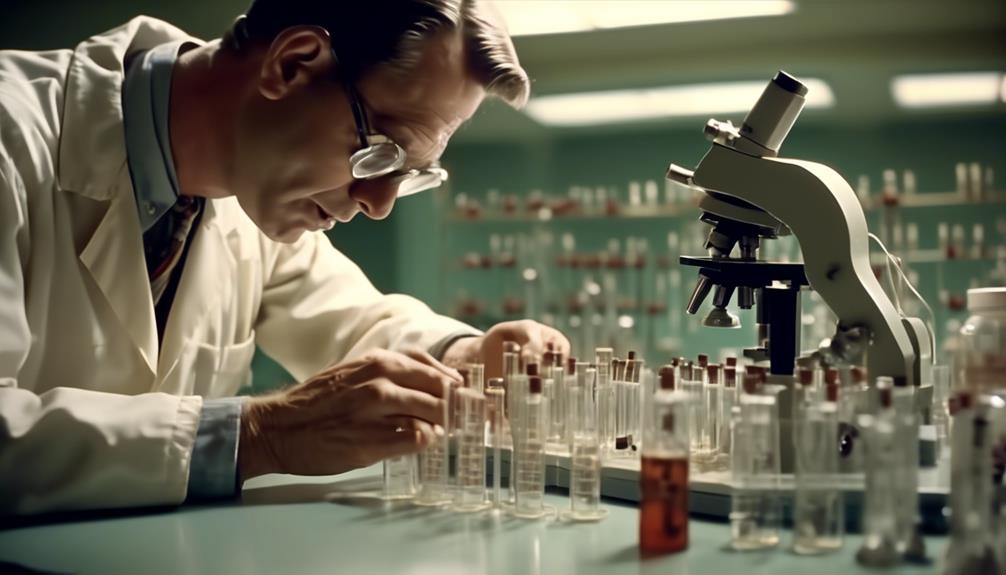Development of the Polio Vaccine (Oral) (1961) – Sabin: Recap and Summary: Oral Vaccine Furthered Polio Eradication Efforts

Dr. Albert Sabin's introduction of the oral polio vaccine in 1961 revolutionized polio eradication efforts.
The oral polio vaccine provided an effective and accessible solution to combat the disease.
This breakthrough ultimately saved countless lives worldwide.
Key Takeaways
- The polio epidemic in the late 1940s and early 1950s led to Dr. Sabin's groundbreaking research.
- Dr. Sabin focused on understanding the poliovirus and developed an oral vaccine for easier administration.
- Extensive clinical trials confirmed the efficacy of the oral vaccine and paved the way for widespread vaccination programs.
- Overcoming technical, logistical, regulatory, and safety challenges is crucial in vaccine development and eradication efforts.
The Polio Epidemic and Dr. Sabin's Research
During the Polio Epidemic, Dr. Sabin conducted groundbreaking research that played a crucial role in the development of the polio vaccine. The polio epidemic, which occurred between the late 1940s and early 1950s, was a time of great fear and devastation. Polio, a highly contagious disease that primarily affected children, caused paralysis and even death.
Dr. Sabin, a virologist and medical researcher, dedicated himself to finding a solution to this devastating disease. His research focused on understanding the poliovirus and developing a vaccine that could be administered orally. His approach differed from the previously developed injectable vaccine, as it offered greater ease of administration and improved coverage. Dr. Sabin's research involved extensive laboratory experiments and clinical trials, which allowed him to refine the vaccine and ensure its safety and efficacy.
The results of Dr. Sabin's research were groundbreaking. His oral polio vaccine, known as the Sabin vaccine, was a game-changer in the fight against polio. The vaccine proved highly effective in preventing polio and played a significant role in eradicating the disease in many parts of the world. Dr. Sabin's research not only saved countless lives but also paved the way for future developments in vaccine technology.
Discovering the Efficacy of the Oral Vaccine
The efficacy of the oral polio vaccine was discovered through rigorous scientific testing and analysis. Clinical trials played a crucial role in determining the vaccine's effectiveness in preventing polio infections.
- Meticulous Clinical Trials: Extensive clinical trials were conducted to evaluate the efficacy of the oral polio vaccine. These trials involved administering the vaccine to a large sample of individuals and monitoring their immune response and subsequent protection against the disease. The results of these trials provided concrete evidence of the vaccine's ability to prevent polio.
- Comparative Studies: Researchers also conducted comparative studies to assess the efficacy of the oral vaccine against other existing polio vaccines. By comparing the outcomes of different vaccine formulations, they were able to identify the oral vaccine as a highly effective option for polio prevention.
- Long-Term Follow-Up: To determine the long-term efficacy of the oral vaccine, researchers conducted follow-up studies on vaccinated individuals over an extended period. These studies demonstrated that the oral vaccine provided long-lasting immunity against polio, further solidifying its efficacy.
Through the systematic and rigorous analysis of clinical trial data, researchers were able to establish the high vaccine efficacy of the oral polio vaccine. This crucial discovery paved the way for widespread vaccination programs and contributed significantly to the global efforts to eradicate polio.
Overcoming Challenges in Vaccine Development
When it comes to vaccine development, there are numerous challenges that need to be overcome. These challenges can range from technical hurdles, such as finding the right formulation and dosage, to logistical obstacles, such as ensuring the vaccine reaches those in need.
Additionally, there are regulatory and safety considerations that must be addressed. However, by employing innovative strategies, collaborating with international partners, and conducting rigorous research, these obstacles can be successfully navigated, leading to the development of effective vaccines that can save lives.
Vaccine Development Challenges
Developing vaccines can present numerous challenges that require careful consideration and innovative solutions. These challenges arise due to the complexity of creating effective vaccines and the constant need to stay ahead of rapidly evolving pathogens.
Some of the key obstacles faced in vaccine development include:
- Vaccine effectiveness: Ensuring that the vaccine provides sufficient protection against the targeted disease is crucial. Extensive research and testing are necessary to determine the optimal formulation and dosage for maximum efficacy.
- Research advancements: Keeping up with the latest scientific advancements is essential for vaccine development. Researchers must continuously explore new technologies and techniques to improve vaccine production, delivery, and safety.
- Regulatory hurdles: Meeting the stringent regulatory requirements for vaccine approval can be a lengthy and expensive process. Strict safety and efficacy standards must be met to ensure public trust and confidence in the vaccine.
Overcoming these challenges requires collaboration between scientists, regulators, and healthcare professionals, as well as continuous investment in research and development.
Overcoming Obstacles
To overcome the challenges faced in vaccine development, researchers must navigate a complex landscape of vaccine effectiveness, research advancements, and regulatory hurdles.
One of the main challenges is ensuring that the vaccine is both safe and effective. This requires extensive testing and clinical trials to determine its efficacy and to identify any potential side effects.
Additionally, researchers must constantly stay updated on the latest advancements in scientific knowledge and technology in order to develop more effective vaccines.
Strategies used to overcome these challenges include collaboration between scientists and researchers from different disciplines, sharing of data and resources, and the establishment of regulatory frameworks to ensure the safety and efficacy of vaccines.
Clinical Trials and Safety of the Oral Vaccine
Now let's examine the trial results and efficacy of the oral polio vaccine.
It's important to assess the vaccine's ability to induce immune response and prevent the transmission of the poliovirus.
Additionally, safety considerations are crucial in evaluating the potential risks and adverse effects associated with the vaccine.
Understanding these aspects plays a vital role in determining the effectiveness and overall safety of the oral polio vaccine.
Trial Results and Efficacy
The clinical trials conducted to assess the safety and efficacy of the oral polio vaccine yielded promising results. Here are the key findings from these trials:
- High Vaccine Efficacy: The oral polio vaccine demonstrated a high level of efficacy in preventing polio infection. In fact, the trials showed that the vaccine was able to provide immunity to more than 90% of the individuals who received it.
- Reduction in Polio Cases: The trials also revealed a significant reduction in the number of reported polio cases among the vaccinated population. This indicated that the oral vaccine was effective in preventing the spread of the poliovirus.
- Long-lasting Protection: Another important finding was that the protection provided by the oral vaccine was long-lasting. The trials showed that individuals who received the vaccine remained immune to polio for an extended period of time, helping to prevent future outbreaks.
These trial results highlight the effectiveness of the oral polio vaccine in eradicating polio and offer hope for a polio-free world.
Safety Considerations
Safety considerations play a crucial role in the development and evaluation of the oral polio vaccine, ensuring that it's both effective and safe for widespread use. Clinical trials are conducted to assess the safety of the vaccine and to identify any potential side effects. These trials follow stringent safety regulations to protect the participants and ensure accurate data collection.
The safety of the vaccine is carefully monitored throughout the trials, and any adverse events are thoroughly evaluated. Common side effects of the oral polio vaccine may include mild gastrointestinal symptoms such as nausea, vomiting, or diarrhea. Serious adverse events are rare but are closely monitored to ensure the ongoing safety of the vaccine.
Sabin's Advocacy for Global Vaccination Campaigns
Sabin's advocacy for global vaccination campaigns has played a pivotal role in advancing the eradication efforts of polio. His unwavering commitment to global vaccination initiatives and his tireless advocacy efforts have made a significant impact in the fight against this devastating disease.
Here are three key reasons why Sabin's advocacy has been crucial:
- Raising awareness: Sabin recognized the importance of raising awareness about polio and the need for vaccination. Through his advocacy efforts, he successfully brought the issue to the forefront of public consciousness, mobilizing support and resources for global vaccination campaigns.
- Building partnerships: Sabin understood that eradicating polio required collaboration and cooperation on a global scale. He worked tirelessly to build partnerships with governments, international organizations, and communities around the world, fostering a united front against the disease.
- Ensuring access: Sabin was a strong advocate for ensuring equitable access to vaccines for all, regardless of socio-economic status or geographical location. He fought to make vaccines affordable and accessible to even the most marginalized populations, ensuring that no one would be left behind in the battle against polio.
Through his advocacy efforts, Sabin transformed the global landscape of polio eradication. His commitment to global vaccination campaigns continues to inspire and guide efforts to this day, bringing the world closer to a polio-free future.
Implementing Oral Vaccine Programs Worldwide
Implementing oral vaccine programs worldwide has been a critical strategy in the global efforts to eradicate polio. The implementation of these programs involves the coordination of various global strategies and extensive community engagement. Governments, international organizations, and local communities have come together to ensure the success of these programs.
To implement oral vaccine programs globally, a multi-faceted approach is employed. Firstly, partnerships are formed between governments and international organizations such as the World Health Organization (WHO) and UNICEF. These partnerships provide the necessary resources and expertise to carry out vaccination campaigns effectively. Additionally, extensive research and development efforts have been made to improve the efficacy and accessibility of oral polio vaccines.
Community engagement plays a vital role in the implementation of oral vaccine programs. Local communities are educated about the importance of vaccination and are actively involved in the planning and execution of vaccination campaigns. This approach fosters trust and ensures widespread acceptance of the vaccine. Community leaders, healthcare workers, and volunteers are key players in reaching remote and marginalized populations, where polio remains a significant challenge.
Implementing oral vaccine programs worldwide requires a systematic and coordinated effort. By implementing global strategies and engaging communities, significant progress has been made in eradicating polio. However, it's crucial to maintain momentum and continue these efforts until polio is completely eradicated.
Impact of the Oral Vaccine on Polio Incidence Rates
With the successful implementation of oral vaccine programs worldwide, it's crucial to examine the impact of this vaccination strategy on polio incidence rates. The oral vaccine has had a significant impact on public health and global vaccination efforts, leading to a drastic reduction in polio cases.
Here are three key points to consider:
- Substantial decrease in polio incidence: Since the introduction of the oral vaccine, there's been a remarkable decline in the number of polio cases globally. This vaccine has played a pivotal role in reducing the transmission of the poliovirus, resulting in a significant decrease in polio incidence rates. This decline is a testament to the effectiveness and wide-scale adoption of the oral vaccine.
- Enhanced herd immunity: The oral vaccine not only protects vaccinated individuals but also contributes to the development of herd immunity. When a large proportion of the population is immunized, the spread of the poliovirus is hindered, further reducing the incidence of polio. This has been instrumental in curbing the transmission of the virus and preventing outbreaks.
- Global eradication efforts: The oral vaccine has been a cornerstone of global polio eradication efforts. Its ease of administration, affordability, and long-lasting immunity have made it a preferred choice in regions where access to healthcare resources may be limited. The widespread use of the oral vaccine has brought us closer to eliminating polio, making it a crucial tool in the fight against this debilitating disease.
Future Prospects: Towards Polio Eradication
The path towards polio eradication holds promise for a future free from the burden of this debilitating disease. Despite the progress made in reducing polio cases globally, there are still significant challenges faced in achieving complete eradication.
One of the major challenges is ensuring vaccine access in remote and conflict-affected areas. This requires strong global efforts to improve infrastructure, logistics, and security to reach every child with the polio vaccine.
Another challenge is addressing vaccine hesitancy and misinformation. Some communities have faced resistance to vaccination, leading to outbreaks in previously polio-free areas. To overcome this, education campaigns and community engagement are crucial, emphasizing the safety and efficacy of the polio vaccine.
Furthermore, surveillance and monitoring are essential to detect and respond to new cases quickly. Strengthening disease surveillance systems and maintaining high immunization coverage are vital in preventing polio resurgence.
Global efforts, such as the Global Polio Eradication Initiative (GPEI), have played a significant role in driving progress towards eradication. This initiative, led by national governments, WHO, Rotary International, CDC, and UNICEF, has mobilized resources, expertise, and political commitment to tackle polio globally.
With continued dedication and collaboration, we can overcome these challenges and achieve a polio-free world. The global community must remain focused on the goal of eradicating polio, ensuring no child suffers from this preventable disease.
Frequently Asked Questions
How Many Doses of the Oral Vaccine Are Required for Immunity?
To achieve immunity, you typically need two to three doses of the oral vaccine. The effectiveness of the oral vaccine has been proven in eradicating polio, making it an important tool in public health efforts.
What Were the Specific Challenges Faced During the Clinical Trials of the Oral Vaccine?
During the clinical trials of the oral vaccine, challenges included safety concerns, dosage determination, and monitoring of side effects. Like navigating a treacherous path, these obstacles had to be overcome for successful development.
How Did Dr. Sabin Contribute to the Global Vaccination Campaigns Apart From His Research?
Dr. Sabin contributed to global vaccination campaigns by advocating for public health initiatives and collaborating with international organizations. His efforts extended beyond research and played a crucial role in the eradication of polio worldwide.
Are There Any Side Effects Associated With the Oral Vaccine?
Sure, here's a 35-word answer for you:
"Side effects of the oral vaccine are rare and mild, including temporary digestive issues. Its effectiveness in eradicating polio has been proven, making it a vital tool in global vaccination campaigns."
What Are the Current Strategies Being Implemented to Achieve Polio Eradication Using the Oral Vaccine?
To achieve polio eradication using the oral vaccine, current strategies focus on addressing challenges like vaccine hesitancy and reaching remote areas. The impact of the oral vaccine on global polio cases has been significant, reducing transmission and bringing us closer to a polio-free world.








